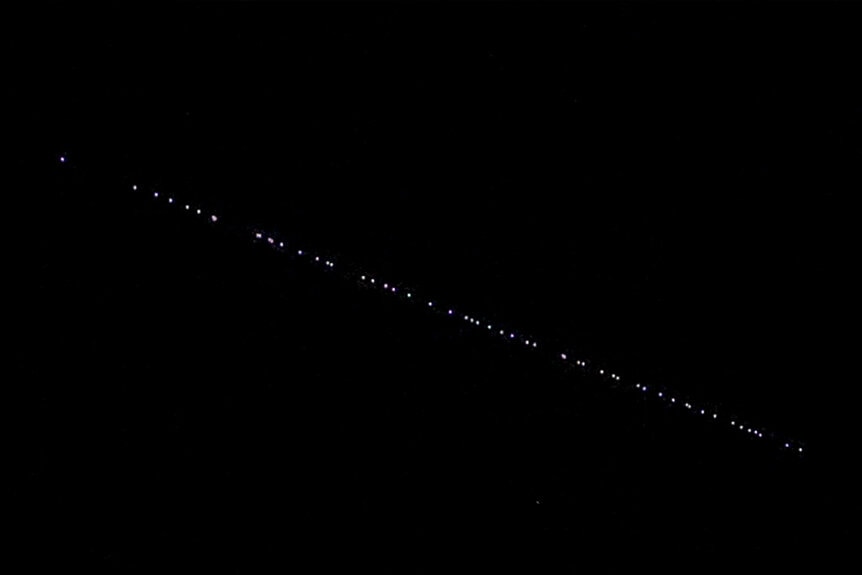Create a free profile to get unlimited access to exclusive videos, sweepstakes, and more!
'Alien' Strings of Light in the Night Sky Have an Earthly Explanation
They're cool, but they're not that cool.

For centuries, and especially for the last century, we’ve been harboring a not-so-lowkey obsession with extraterrestrials. It’s in the news, from sightings to abduction reports, and it’s in our stories, big time. Cowboys & Aliens, Monsters vs Aliens, They Live, The Thing, The Last Starfighter, The Fourth Kind, Battlestar Galactica, Europa Report, The Visitor, SYFY's Resident Alien… the list goes on. And with sightings of UFOs (or UAPs, as the case may be) growing in recent years, you might be spending more time than usual keeping an eye on the night sky. In fact, recently there have been reports in a number of states in the U.S. describing a trail of bright lights moving quickly across space.
Most of the time, you can handwave an unusual sighting with one of the usual explanations. A light in the night sky is usually an airplane or a planet, and amateur drone aircraft can explain a lot of sightings, including those with erratic movements. If none of those explanations work for you, perhaps you’ll consider weather balloons or swamp gas. And, of course, there’s always the outside possibility that world governments really are operating advanced aircraft reverse engineered from captured alien technology. Who’s to say?
RELATED: Are Recent UFO Sightings Evidence of Secret Alien Visitation? (Probably Not)
More likely, what you’re seeing is one of the literal thousands of satellites we’ve deployed into orbit around the Earth. Together, they create their own artificial constellation which behaves differently than any of the other points of light you’ll see in the sky, and that constellation is getting bigger.
One of the biggest contributors to the growing satellite population is Elon Musk’s Starlink, operated as a part of SpaceX. It is intended to provide reliable satellite-based internet access all over the world, but before it can do that, Starlink needs to launch a whole lot of satellites.
The first cluster of 60 Starlink satellites was launched May 23, 2019, and they’ve been launching pretty much nonstop ever since. At the time of writing, more than 80 launches have been carried out, carrying a total of more than 4,000 Starlink satellites. The most recent launch occurred May 4, 2023, carrying 56 satellites to their orbital destination 330 miles (530 kilometers) above Earth. It’s that launch which is likely responsible for recent UAP (Unidentified Aerial Phenomena) sightings.
By the time the satellites get to their permanent home and are correctly oriented, most of their reflected light is directed away from Earth, rendering them effectively invisible to the naked eye. But it takes a little time for them to get perfectly nestled into position. In the interval between being deployed and final adjustments, they could orbit the Earth several times, and they’re likely to be more reflective during this period. It’s also worth noting that even after they are in position, they can get in the way of amateur and professional astronomers trying to glimpse faint and distant objects through the morass.
What you end up with is a few dozen shiny satellites dumped into a dark sky all at the same time, where they can bounce light back toward the ground. Moreover, because of the way Starlink satellites are deployed they follow one another like a family of baby ducks arcing across the sky. The upshot is a chain of bright lights moving swiftly through the dark before fading to black. It looks like an artificial craft behaving weirdly because it is. It’s the kind of thing that could be confusing or even alarming if you’re not expecting it and don’t know what you’re seeing.
As Starlink continues to build out their global internet infrastructure, sightings of strung-together lights in the sky are likely to continue. The FCC granted approval for SpaceX to deploy an additional 7,500 next-generation Starlink satellites. If you missed the most recent batch of Starlink satellites, there’s a good chance you’ll be able to see the next one or the one after that. Enter your city and state or coordinates into the Find Starlink website or app to get a list of times Starlink satellites will be visible.
And in the meantime, gorge yourself on the buffet of alien-themed content streaming on Peacock, including the first two seasons of Resident Alien starring Alan Tudyk.































